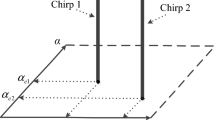Abstract
Traditional stepped-frequency chirp pulse train methods suffer from high sidelobes and difficulty in compensating for the Doppler effect caused by target motion. This paper investigates a class of non-linear stepped-frequency chirp pulse train which has low sidelobes and the capability to cancel clutter and to compensate for target motion. A new Doppler matched filter has been developed for estimation of the target’s radial velocity, which avoids the multiple bursts required by other methods. The high signal-to-noise ratio resulting from the application of sub-pulse compression improves the accuracy of estimation. The Cramer–Rao bound for the lower limit on the velocity estimation is derived to demonstrate the performance of the proposed method.








Similar content being viewed by others
References
Wehner, D. R. (1995). High-resolution radar (2nd ed.). Norwood, MA: Artech House.
Daniel, J. R. (2002). Nonlinear synthetic wideband waveforms. In Proceedings of the IEEE radar conference, 2002 (pp. 212–219). doi: 10.1109/NRC.2002.999721.
Lord, R. T., & Inggs, M. R. (1997). High resolution SAR processing using stepped-frequencies. In Proceedings of IEEE international geoscience and remote sensing symposium (IGARSS’97) (Vol. 1, pp. 490–492). doi: 10.1109/IGARSS.1997.615924.
Zhang, Q., & Jin, Y. Q. (2006). Aspects of radar imaging using frequency-stepped chirp signals. Eurasip Journal on Advanced Signal Processing, doi: 10.1155/ASP/2006/85823.
Benjamin, C. F., Jae, S. S., & Salim, T. (2001). Efficient method for the translational motion compensation of inverse synthetic aperture radar imagery. Optical Engineering, 40(3), 433–442. doi:10.1117/1.1349215.
Levanon, N. (2002). Stepped-frequency pulse-train radar signal. IEE Proceedings Radar, Sonar and Navigation, 149(6), 297–309. doi:10.1049/ip-rsn:20020432.
Zhang, Q., Yeo, T. S., & Du, G. (2003). ISAR imaging in strong ground clutter using a new stepped-frequency signal format. IEEE Transactions on Geoscience and Remote Sensing, 41(5), 948–952. doi:10.1109/TGRS.2003.811760.
Levanon, N., & Mozeson, E. (2004). Radar signals. New Jersey: Willey.
Skolnik, M. I. (1990). Radar handbook (2nd ed.). New York: McGraw-Hill.
Levanon, N., & Mozeson, E. (2003). Nullifying ACF grating lobes in stepped-frequency train of LFM pulses. IEEE Transactions on Aerospace and Electronic Systems, 39(2), 694–703. doi:10.1109/TAES.2003.1207275.
Berens, P. (1999). SAR with ultra-high range resolution using synthetic bandwidth. In Proceedings of IEEE international geoscience and remote sensing symposium (IGARSS ‘99), (Vol. 3, pp. 1752–1754). doi: 10.1109/IGARSS.1999.772084.
Gladkova, I., & Chebanov, D. (2005). Suppression of grating lobes in stepped-frequency train. In Proceedings of the IEEE Radar Conference, 2005 (pp. 371–376). doi: 10.1109/RADAR.2005.1435853.
Shen, Y. Y., & Liu, Y. T. (1999). A step pulse train design for high resolution range imaging with Doppler resolution processing. Chinese Journal of Electronics, 8(2), 196–199.
Liu, Z., & Zhang, S. H. (2000). Estimation of target motion parameter in a stepped-frequency pulses radar. ACTA Electronica Sinica, 28(3), 43–45. doi:cnki:ISSN:0372-2112.0.2000-03-011.
Wang, G. L., & Li, X. G. (2008). Compound approach of measuring velocity based on step-frequency and pulse Doppler system. Journal of Infrared Millimetre Waves, 27(3), 190–192. doi:cnki:SUN:HWYH.0.2008-03-007.
Chen, H. Y., Liu, Y. X., Jiang, W. D., & Guo, G. R. (2006). A new approach for synthesizing the range profile of moving targets via stepped-frequency waveforms. IEEE Geoscience and Remote Sensing Letters, 3(3), 406–409. doi:10.1109/LGRS.2006.873874.
Acknowledgments
The author would like to thank the anonymous reviewers and editors for their helpful comments and suggestions.
This work is supported by the foundation of Equipment in Advance No. 9140A07050806DZ0229.
Author information
Authors and Affiliations
Corresponding author
Rights and permissions
About this article
Cite this article
Hu, Y., Wang, X. & Chen, Z. Motion Target Imaging by Non-Linear Stepped-Frequency Chirp Pulse Train. Sens Imaging 10, 41–53 (2009). https://doi.org/10.1007/s11220-009-0045-y
Received:
Revised:
Published:
Issue Date:
DOI: https://doi.org/10.1007/s11220-009-0045-y




